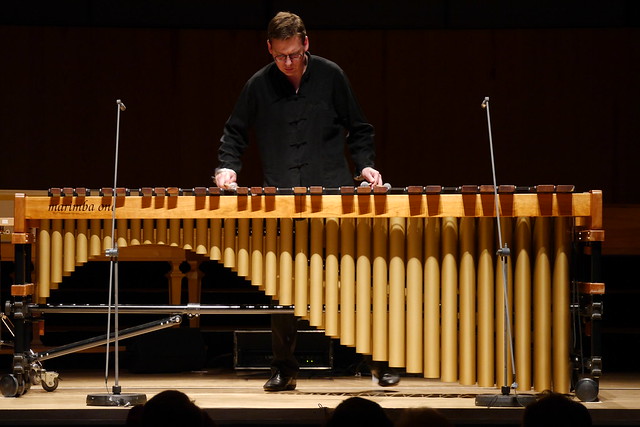The Marimba has come a long way - both geographically and technically speaking. The proto-marimba has long been a part of Amazonian, West African, and Central American cultures. In our society, they are the epitome of a classy, well respected instrument usually featured in high culture circles (such as in academia and orchestras). Marimbas are one of the most beautiful sounding percussion instruments. While very long and heavy, marimbas are capable of making very low to high tones that add an ethereal quality to many music pieces.
People interested in percussion (and perhaps even piano, since the overall layout is somewhat similar) should study and master the marimba. While playing the marimba is standard on the collegiate level, not too many people play the marimba before or after college, which is a shame. Although high school students may briefly encounter the marimbas in marching bands and drum and bugle corps, it is usually an insufficient amount of time to truly appreciate the complexity and necessity of this instrument.
is standard on the collegiate level, not too many people play the marimba before or after college, which is a shame. Although high school students may briefly encounter the marimbas in marching bands and drum and bugle corps, it is usually an insufficient amount of time to truly appreciate the complexity and necessity of this instrument.
 |
| Marimba - Photo by tottr (cc) |
The reason for the high concentration of marimba playing in college, as opposed to any other time, is that marimbas are very expensive instruments. Often running a couple thousand dollars, they are too expensive for the average person. However, many reputable music schools should have one or two of these at their disposal, and these places make for great practice areas (besides the fact that a professional will be teaching you proper technique). There are affordable ways to get behind a marimba - do it!
The marimba is composed of metal keys of varying lengths hit by soft yarn mallets to produce varying tones. Many marimba players play using two mallets, or even using two mallets in each hand (resulting in four mallets being used simultaneously). Some of the more advanced players can use even more mallets...which is truly amazing. There are many techniques to striking the marimba, so a good deal of emphasis is placed on proper mallet holding methods. Depending on your personal style/capabilities and your teacher's personal preference, you may learn the "traditional grip", the "Burton grip", or the "Stevens grip", amongst many others.
The marimba is an octave lower (an octave is equivalent to eight complete notes) than its smaller counterpart, the xylophone . The main difference between the two instruments is the resonators featured on the marimba. These resonators (usually made of a light metal such as aluminum) are of different lengths and widths to help the marimba achieve its varying sounds. For the lower sounding notes, the resonators beneath the keys sometimes have to bend so as not to go straight through the floor!
. The main difference between the two instruments is the resonators featured on the marimba. These resonators (usually made of a light metal such as aluminum) are of different lengths and widths to help the marimba achieve its varying sounds. For the lower sounding notes, the resonators beneath the keys sometimes have to bend so as not to go straight through the floor!
Although many people are more familiar with the xylophone, the marimba serves as a sort of backbone in orchestras, ensembles, and bands. They are currently very popular in percussion ensembles, jazz ensembles, and marimba concertos. Any musician with serious musical aspirations simply must explore this wonderful and challenging instrument.
Are you interested in all things involving music?...
For the best variety of sheet music, click here to find everything you are looking for! If you want to peruse the largest selections of musical instruments, DJ equipment, or recording devices, click here! (7.2017 - Links not working)
|

No comments:
Post a Comment